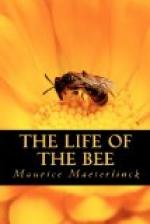Buchner cites an analogous fact. In the Barbadoes, the bees whose hives are in the midst of the refineries, where they find sugar in abundance during the whole year, will entirely abandon their visits to the flowers.
[103 ]
So much for what our own eyes can see. It will be admitted that we have mentioned some curious facts, which by no means support the theory that every intelligence is arrested, every future clearly defined, save only the intelligence and future of man.
But if we choose to accept for one moment the hypothesis of evolution, the spectacle widens, and its uncertain, grandiose light soon attains our own destinies. Whoever brings careful attention to bear will scarcely deny, even though it be not evident, the presence in nature of a will that tends to raise a portion of matter to a subtler and perhaps better condition, and to penetrate its substance little by little with a mystery-laden fluid that we at first term life, then instinct, and finally intelligence; a will that, for an end we know not, organises, strengthens, and facilitates the existence of all that is. There can be no certainty, and yet many instances invite us to believe that, were an actual estimate possible, the quantity of matter that has raised itself from its beginnings would be found to be ever increasing. A fragile remark, I admit, but the only one we can make on the hidden force that leads us; and it stands for much in a world where confidence in life, until certitude to the contrary reach us, must remain the first of all our duties, at times even when life itself conveys no encouraging clearness to us.




